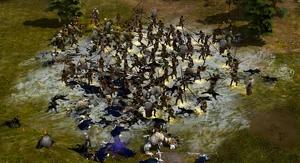The hill-men of Rhudaur are secondary antagonist from The Lord of the Rings: The Battle for Middle-earth II: The Rise of the Witch-king and The Lord of the Rings Online. They were wild men of several tribes, minions of the Witch-king and they also served in his army.
History[]
Battle for Middle Earth II, Rise of the Witch-king[]

A black Númenórean thrall master incite the hill-men of Rhudaur against the Dunedains.
Almost nothing is known about the origin of the hillmen, it is certain that they lived in the northern part of Middle-earth, in the weakest kingdom of Arnor, Rhudaur. There was almost never peace in this area, as the hill-men were also divided, and there were also frequent fights against the Dunedains. After the Witch-king united Angmar and established his kingdom, his first target was Rhudaur, where a major uprising had broken out. The uprising was led by a hill-chief named Hwaldar, who was secretly the agents of the Witch-king’s right-hand, Morgomir, and who incited constant hatred against the Dunedains. During a battle, however, he was captured and taken to a camp, but this was not the end of the fighting, but after that the really bloody clashes began. Because the royalists and the followers of Angmar fought each other in open battles and the fights were almost constant. The king of Arthedain, Argeleb I, set out with a strong army to crush the uprising and finally unite Arnor, but then the Witch-king also set out with the armies of Angmar. Angmar's henchmen and the royalists fought each other in four villages, and Hwaldar was in a southern Dunedain camp. The forces of Angmar encountered a small group of hill-men who led them to the southern camp, which they completely destroyed, the Dunedains all killed, and Hwaldar freed. After that, the number of henchmen increased and they captured the villages one after the other and killed all the royalists. In the territory of Rhudaur there were two fortress, which were strongly defended, and the Dunedains launched several counterattacks, but they were all destroyed. After one of the fortresses was destroyed, King Argeleb I arrived with his army, but the king was too overconfident and launched an immediate attack on the recently built fortress of Angmar. This ended in a serious defeat, Argeleb was killed in battle, and then the second fortress and all enemy buildings were destroyed. The uprising swept away the Dunedains, Hwaldar became one of Angmar's important lieutenants, and Rhudaur became part of Angmar.
The hill-men took part in almost every major battle thereafter. They took part in the siege of Amon Sul, recovering the palantir pieces, but their greater role was in the invasion of Cardolan. Here the army of Angmar won a great victory, and the hill-men took an active part in plundering the tombs of the kings and the kingdom. After that, the hill-men got a more serious role when Angmar launched the final attack against Arthedain and Fornost. After the defeat of Arnor, the united armies of Gondor and the Elves battled the armies of the Witch-king and Angmar not far from the ruins of Fornost. The forces of evil were also helped by the hill-men, but they were defeated. After the final defeat of Angmar, Rhudaur became completely uninhabited, all the evil hill-men being killed, but it is possible that there were survivors.
Weapons[]
The preferred weapons of the hill-men were spears and axes. Their spears were thin but long, with a thick tip and effective against cavalry. Their axes were usually thrown at the enemy and were effective against infantry. There were those who used various peasant tools, mainly pitchforks, spades, and stone axes. The hill-men did not wear armor, they always wore thick clothes or coats made of fur.










